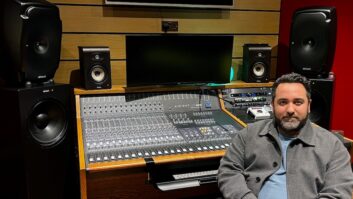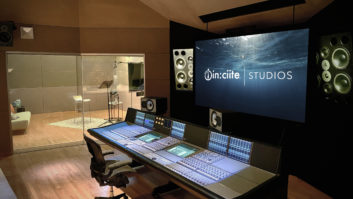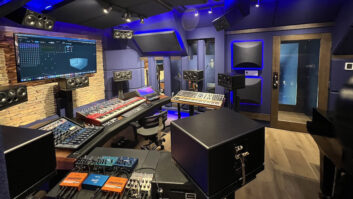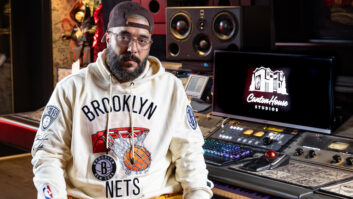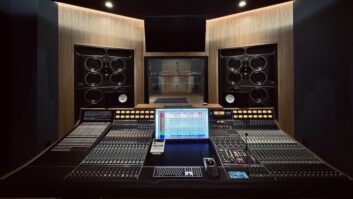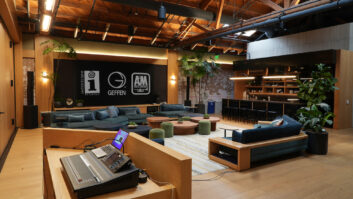Skyland Studios’ Darren Rust maximizes every inch of space in his Minneapolis-based home to create a wide-open sound.
photo: Gerri Rust
Vocal and a cappella groups usually want a warm, clean, big and wide sound that comes through, even on layer upon layer of vocal tracks. But when you don’t have the real estate or resources for an expansive room to get that sound, you’ve got to make the most of whatever space you’ve got. Darren Rust, a producer, engineer, arranger and leader of his own vocal group, The Blenders, has learned how to squeeze every bit of sonic integrity out of his mid-sized Skyland Studios, which he opened six years ago in his Minneapolis-area home.
Dave Ahl, known around the Twin Cities for his work on local facilities such as The Terrarium, Babble-On and, probably most famously, Jimmy Jam and Terry Lewis’ Flyte Tyme Productions, designed Skyland Studios with vocal recording in mind. The 12×10-foot recording room can hold a small group of musicians, vocalists or, if necessary, a drum kit. “We don’t do it very often, but we have done it,” says Rust.
The 13×24-foot control room is the hub of Rust’s activities; it’s designed and equipped for editing, post-production and mixing. Rust works on a Pro Tools|HD Accel workstation (192 I/O) paired with Apogee Rosetta 200 AD/DA converters and a Dangerous Music 2-Bus analog summing mixer. Software includes Spectrasonics Stylus RMX, Trilogy and Atmosphere; IK Multimedia SampleTank; Waves Platinum Suite plug-ins; Sony Oxford plugs; Digidesign ReVibe reverb; Synchro Arts VocALign; Apple Final Cut Pro (for video editing); and Antares Auto-Tune 4. A Mackie board serves as his control surface. He can mix to two Alesis MasterLink ML-9600 mixing/mastering systems, and he monitors through a pair of Mackie HR824s and/or Yamaha NS-10s.
Because of Rust’s affinity for spot-on vocal tracks, as well as analog processing equipment, the musician/producer also stocks his studio with ample outboard gear, including API 5502 EQ and 512b pre’s, a Great River EQ-2NV, TL Audio C2 compressor, Summit TLA-100a and Alan Smart C2 stereo compressors, among other items.
To capture a wide-open vocal sound without a wide-open space, Rust invested in a few choice microphones, including a Sony C-800G and AKG C 12VR tube mics, a few AKG C 414s and a RØDE Classic tube mic. “For one Blenders session, we quadrupled every part in our group,” says Rust. “We had six- and seven-part chords stacked over 35 tracks of vocals, and the RØDE mic worked great.”
Although a lot of Skyland’s clients come from the Minneapolis area (including his own group), a large portion of Rust’s work comes from out-of-state, if not outside the U.S. “I do a lot of editing and mixing for clients who track elsewhere,” he says. “Because of the Internet, I work with groups and never see them. I’ll mix tracks and then post the mixes on a server for them to download. I just did a small mix project for a group in Switzerland. They sent me Pro Tools files on disc; I sent them everything — references and 24-bit masters — over the Internet.”
Many clients, including Naturally Seven, Sounds of Blackness and 98 Degrees member Jeff Timmons, have come to Skyland after hearing Blenders recordings. St. Paul, Minn. — based jazz vocal quintet Voice Trek wanted a Take 6 — style “Nashville Sound,” and were told they couldn’t get that in the Twin Cities. They heard The Blenders’ song “When It Snows,” which had that sound, found Rust and hired him to mix their eighth album, An A Cappella Trek. “When you are part of a vocal group, what you hear in your monitors onstage is what you want to hear on your recordings,” says Voice Trek member Vicki Plaster. “Darren gave us that.”
With clients scattered all over the globe and the ability to work with them virtually, Rust could certainly take his business to a more music-centered market. “As a producer, I’m always questioning whether I should move to one of the coasts or to Nashville,” he says. “If I were to move, I might find a bigger pool of work. But I have a family, and we’re Midwest people. And I have clients here that keep coming back.”
Besides, Rust believes that the area that spawned Prince and Morris Day & The Time, among others, has potential for resurgence — and he’ll be in the midst of it as a producer, engineer, artist or some combination of the three. “I’ve become a good engineer, but I started out as a musician,” he says. “The writing falls by the wayside when you spend so much time on other people’s albums, but the musicality is there in everything I do. The day I can sit down and write music, I know I will take inspiration from these artists.”

